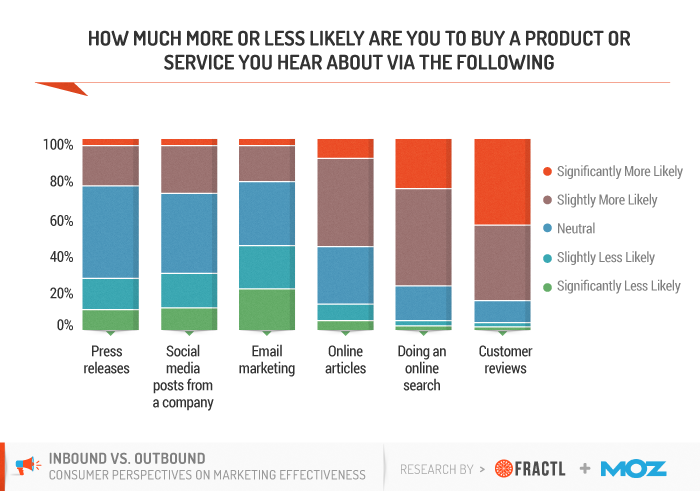Take a look at the graphic above. It’s from research done by Marketo and Moz called “Inbound vs. Outbound: Consumer Perspectives On Marketing Effectiveness.” The research is also summarized in this Marketo post. If you’re unclear upfront, we’re talking about “inbound” (content-driven) marketing vs. “outbound” (ad/PR-driven) marketing and trying to see what actual consumers value. To do a bit of ‘level-set’ here, the basic issues tend to be:
- Content/Inbound Marketing: Is it tied enough to business goals?
- Outbound/Traditional Marketing: Have people learned how to ignore this?
Let’s see what some of this research says, shall we?
Go look at the chart again, above. Actually, we’ll re-paste it here to make things easier:
You want to find areas with big red (significantly more likely to buy) or brown (slightly more likely), and you want to avoid large chunks of green (significantly less likely) and blue (slightly less likely). If you follow that rubric, the most effective channels seem to be:
- Customer reviews
- Doing an online search
- Online articles
This is all somewhat logical, because:
- Referral and word of mouth has always been the king/champion of marketing (“customer reviews” falls in here)
- Doing an online search = ‘power of the customer’ + ‘rise of mobile’ = major shift in marketing
- Online articles = “content is king” = it’s everywhere = that could actually become a problem
The least effective channels, in turn, would be:
- Press releases
- Social media posts from a company
- E-mail marketing
That’s a little bit less logical, because press releases have been a traditional way to get attention for generations (people have a hard time abandoning the traditional), social media is supposed to be this massively powerful thing, and everyone raves about e-mail marketing.
Ah, but here’s the rub:
- Social media only works if it’s social, and most companies don’t get that
- When people in marketing rave about e-mail marketing, it’s usually based on margin; e-mail marketing can be very effective if done right, but the way many companies do it, it just turns people off eventually
This is admittedly just one study, but where do we net out?
Let’s use Marketo’s wording first, then try to analyze a bit:
Although traditional advertising and other forms of outbound marketing tend to have shorter sales cycles and faster ROI, consumers simply aren’t as responsive as they used to be to these tactics.
That’s ‘the nut graf’ or essence of this whole discussion. Because of shorter sales cycles and faster ROI, higher-ranking marketing executives — who only really stay in their jobs a few years, if we’re being honest — want to focus on those things. Most executive-type jobs are about pleasing your boss, and pleasing him/her quickly, so that you don’t have to worry about being kicked down the chain.
That’s where the issue with ‘content’ or ‘inbound’ marketing efforts comes up. To do that right requires a focus on relationships before revenue, and many companies don’t want to make that sacrifice. I had a job recently where the company blogged once a week. I had free time (“bandwidth” is the corporate term, I think) and offered to help them blog more. It never went anywhere; no one really cared. Why? It wasn’t a priority for anyone because it wasn’t immediate revenue. It’s that simple. Money talks, everything else walks.
So what we can learn here:
- You can make money and drive influence with content or inbound marketing
- It does require some discipline
- It does require you to look at financial achievements over a longer timeframe
- Because of the importance of reviews, you need to think about your reputation
- You need to think about the story you’re telling to someone who could buy from you
- Rather than pushing out a high volume of content, focus instead on content that could draw in the types of people you need to find you
- That’s what ‘data-driven marketing’ really is (targeting), even though many CMOs think it means ‘do more’
- Because people always trust their friends, word-of-mouth, and opinions — think about embracing a ‘passionate minority’ approach to marketing
- That does require you to stop praying at The Temple of Big Numbers, which is hard for many people
What else would you add about adoption of content marketing and long-playing it?

